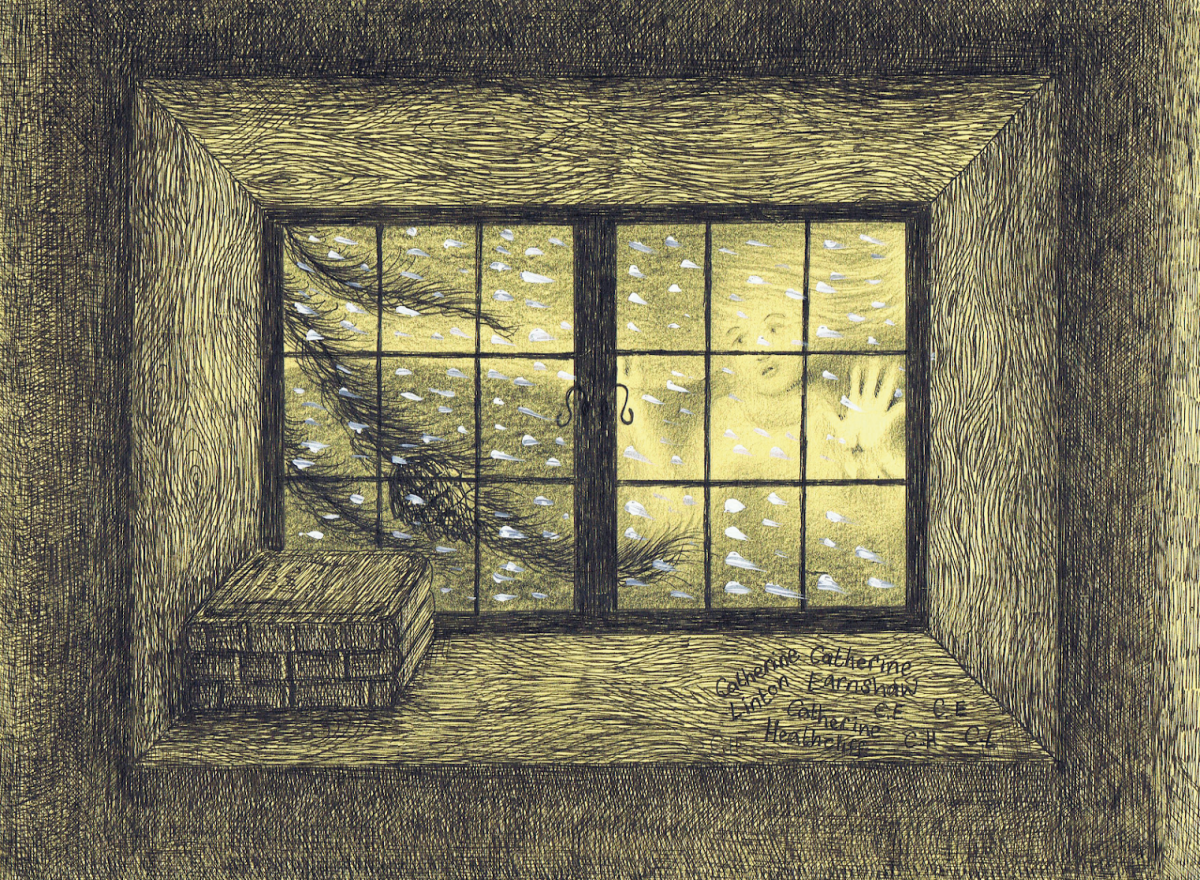Windows in Wuthering Heights are at the forefront of Catherine’s characterization. In Wuthering Heights, windows are a type of barrier, a way to marginalize the person stuck on one side of the window. More often than not, it is Catherine who seems to be marginalized by the windows. Each time that Catherine is displayed at or by the window, Brontë places things in the scene that intensify the marginalization that Catherine undergoes. Each time the window stands between Catherine and something she truly wants. Brontë demonstrates the way in which the window is a barrier for Catherine's metaphorical wants by having it separate the natural and supernatural worlds as well.
Kerina Strevens, "Cathy at the Window," for Emily Brontë, Wuthering Heights, n.d.
When we are first introduced to Catherine’s windowsill, Lockwood arrives at his sleeping quarters where he places his candle beside a pile of stacked up books and next to it her name scratched into it three times. Each time it is followed by a different last name. Lockwood recalls, “The ledge, where I placed my candle, had a few mildewed books piled up in one corner; and it was covered with writing scratched on the paint. This writing, however, was nothing but a name repeated in all kinds of characters, large and small—Catherine Earnshaw, here and there varied to Catherine Heathcliff, and then again to Catherine Linton. In vapid listlessness I lean my head against the window, and continued spelling over Catherine Earnshaw—Heathcliff—Linton” (Brontë 16). From this, we can surmise that the writing in the window is a demonstration of the separation between Catherine and her dreams. The fact that Catherine’s name is etched into the margins of the windowsill only further demonstrates the way in which windows and the theme of marginalization tie into one another. This makes sense in thinking about how each time Catherine appears by the window, in written letters or by a ghost, she is prevented from having something she truly wants. During this scene, Lockwood falls asleep, and Catherine appears to him as white glowing letters spelling out her name: “till my eyes closed; but they had not rested five minutes when a glare of white letters started from the dark, as vivid as spectres—the air swarmed with Catherines; and rousing myself to dispel the obtrusive name, I discovered my candle wick reclining on one of the antique volumes, and perfuming the place with an odour of roasted calf-skin” (Brontë 16). It is curious that Catherine comes to Lockwood in a dream through this window, not to Heathcliff.
Kelley McMorris, "Catherine's Visit," for Emily Brontë, Wuthering Heights, 2012.
This is arguably the second time that Catherine comes to Lockwood as a ghost on that very same windowsill. This time Catherine is not a bunch of letters, but a physical representation of herself. In this scene, Lockwood is awoken by tapping on the window. Still, in a sleep-like state, he punches a hole through the window grabbing ahold of Catherine’s arm which he originally thought was a tree branch. Catherine starts to call out to him: “‘Let me in—let me in... I’m come home. I’d lost my way on the moor (Brontë 21). This is yet another time that Catherine appears at the windowsill as a demonstration of something she cannot have. Catherine is pleading with Lockwood to let her in and instead, he rubs her ghostly arms on the broken glass of the windowsill until they start to bleed. We learn that Catherine’s ghost lingers because Heathcliff wanted to be with Catherine even in death, and so he asks her to haunt him. Lockwood tells an aroused Heathcliff of the event, and Heathcliff goes to the window, pushes it open, and screams: “‘Come in! come in!’ he sobbed. ‘Cathy, do come’” (Brontë 24). The window stands as a barrier between Catherine and Heathcliff, emphasizing her death and ghostly nature.



